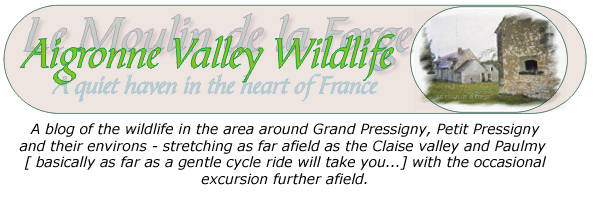... could think a moorhen chick was beautiful. They are bald, beaky balls of black fluff. These two little chaps (taken 25th June) have a certain cuteness about them, I suppose. They usually go to the edge of the millstream under the overhanging vegetation to be fed.
 |
| Wot? Eh wot? Anyone there? |
These two were scrambling around in the iris leaves. They used their stubby wings like grapples to climb over the stems.
 |
| Boo! |
Myrtle is always in charge, of feeding, of cleaning up afterwards, of construction work.
 |
| Removing a faecal sac |
But how many chicks are there? And - how many Myrtles? This bird seems at some point to have injured a wing, and never gets it quite flat against its body.
 |
| Count the fuzzy black blobs. Are they chicks or shadows? |
 |
| Three chicks. And the one at the back is bigger. Hang on, is that another leg? |
 |
| How many chicks? |
 |
| Yes, it's another leg. And where did the other one at the front come from? Five chicks. |
 |
| Brooding |
On Saturday (6th July) it rained heavily. Myrtle swung into action to reinforce her brood platform. On Sunday (7th July) she continued, while the second adult led the chicks upstream out of the way. Myrtle worried at the iris stems around the platform area, her activity highlighted by the sudden onset of vigorous shaking of a small group of leaves that could not be attributed to the water flow. Only occasional glimpses of her could be seen, which is her purpose in selecting that nest site and winning it against all odds. When a leaf finally broke off, she immediately took it to the platform and got weaving. At one point she came in with a poplar leaf, and that went in too. She worked at this for over an hour, while yours truly watched, fascinated.
Myrtle only stopped when a small flotilla of mallards barged through the middle of the iris bed. This was an adult female (
cane) with three well grown youngsters (
canetons) at least as big as she was.
La cane could easily have been "our" duck whose progress we observed over so many weeks. If so, she did well to raise three ducklings to the point where they will soon be independent. Myrtle's crew has a long way to go before that stage.
She had to reinforce the platform again today (14th July). The second adult seemed rather dithery, swimming up and down aimlessly most of the time, although she may have been guarding the chicks again. One chick insists on staying with Myrtle, and was treated to a sharp peck for getting out of hand. In one furious burst of activity the adults were working together, Myrtle (the dominant bird, generally the female in any kind of pair) was working on the platform while her helper carried materials in from the bank.
The helper is probably a daughter, a younger sibling or even an aunt. This kind of cooperation outside the pair bond is found normally between birds that are related. She has a small platform of her own, under the far bank. And some day she may become Myrtle and take over the iris bed.



















No comments:
Post a Comment